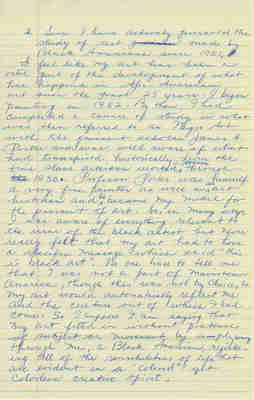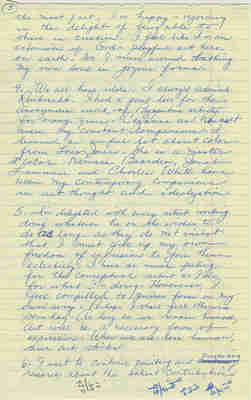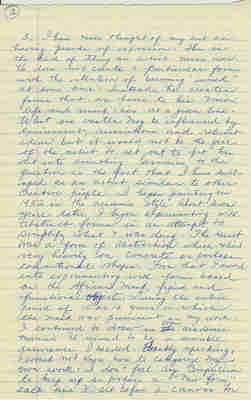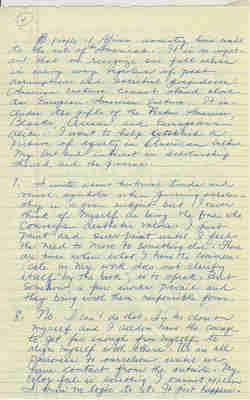Pages
MS01.01.03.B02.F12.006
[HANDWRITTEN IN BLUE INK ON YELLOW LEGAL PAPER]
2. Since I have actively pursued the study of art [crossed out: produced] made by Black Americans since 1951, [crossed out: I] I feel like my art has been a vital part of the development of what has happened in Afro-American art over the past 25 years. I began painting in 1952. By then, I had completed a course of study in what was then referred to as Negro Art with the eminent scholar James A. Porter and I was well aware of what had transpired historically from the time slave artisans worked in America through [crossed out: the] 1950. Professor Porter was himself a very fine painter as well as an art historian and he became my model for the pursuit of art. So, in many ways, I was aware of everything relevant to the issue of the black artist but never really felt that my art had to have a specific message which said "this is black art." No one had to tell me that I was not part of mainstream America, though this was not by choice, so my art would automatically reflect me and the culture out of which I had come. So I suppose I am saying that my art fitted in without pretense of subject or movement, but simply coming through me, a Black American, registering all of the sensibilities of life that are evident in a "colored" yet colorless creative spirit.
MS01.01.03.B02.F12.007
3 the most part, I'm happy -- rejoicing in the delight of being able to share in creation. I feel like I'm an extension of God's playful act here on earth. So I move around bathing my own soul in joyous forms.
4. We all have idols. I always admired Rembrandt. I had a great love for the anonymous work of Byzantine artists for many years. Cezanne and Rouault were my constant companions. I learned an awful lot about color from Lois Jones. She is a master at color. Romare Bearden, Jacob Lawrence and Charles White have been my contemporary companions in art thought and idealization.
5. I'm delighted with every artist working doing whatever he or she wishes to do as long as they do not insist that I must give up my own freedom of expression to join them eclecticly [eclectically]. I have as much feeling for what I'm doing. However, I feel compelled to pursue form in my own way. Perhaps I shall feel otherwise someday. As long as we remain human, Art will be a necessary form of expression. When we are less human, our art stinks.
6. I want to continue painting and pursuing [crossed out: combining] research about the salient contributions.
[HANDWRITTEN COLUMNS OF ADDITION AT EDGE OF PAGE]
MS01.01.03.B02.F12.008
[HANDWRITTEN]
2
3. I have never thought of my art as having periods of expression. This is the kind of thing an artist never does. He does not create a particular form with the intention of becoming "ismed" at some time. Instead, he creates forms that are basic to his vision, life and sensibilities at a given time. What one creates may be influenced by environment, associations and relevant ideas but it would not be the goal of the artist to set out to "fit" his art into something. Germaine [Germane] to the question is the fact that I have developed as an artist similar to other creative people. I began painting in 1952 in the academic style. About seven years later, I began experimenting with abstract forms in an attempt to simplify what I was doing. The result was a form of Abstraction which relied very heavily on concrete or perhaps conventional shapes. From that I moved into experimenting with forms based on the African Mask, figure and functional objects. During the entire period of 10 or 12 years in which the mask was prominent in my work. I continue to draw in [crossed out: the] an academic manner. It seemed to be a sensible assurance I needed. Frankly speaking, I would not know how to categorize my own work. I don't feel any compulsion to keep up or produce a "new form" each time I sit before a canvas. For
[CONTINUED ON PAGE "4"]
MS01.01.03.B02.F12.009
[HANDWRITTEN]
[CONTINUED FROM PAGE "3"]
4
people of African ancestry have made to the arts of the Americas. It is so important that we recognize our full selves in every way regardless of past assumptions and societal prejudices. American culture cannot stand alone as European-American culture. It includes the gifts of the Native American, Blacks, Asians and Europeans alike. I want to help establish a picture of equity in American culture. My Art and interest in scholarship should aid the process.
7. I write about historical trends and visual symbols when pursuing scholarship in a given subject, but I never think of myself as being the One who conveys aesthetic values. I just paint and over-paint until I feel the need to move to something else. There are times when what I have to communicate in my work does not clarify itself "by the book", so to speak. But somehow, a few works prevail and they bring with them responsible forms.
8. No. I can't do that. I'm too close on myself and I seldom have the courage to get far enough from myself to align myself with others. We are all prisoners to ourselves until we have contact from the outside. My color feel is something I cannot explain. I know no logic to it. It just happens.
[CONTINUED ON PAGE "5"]
MS01.01.03.B02.F12.010
[HANDWRITTEN]
[CONTINUED FROM PAGE "4"]
5
(9) Well, it goes without saying that black people are still not a part of the mainstream of our nation though we have made certain cultural [crossed out: and] social and economic gains. We cannot afford the luxury of thinking we are near "the promised land". We are still "on our way to Caanan land". We are only one step ahead of our ancestors, and must affirm our position with projections of excellence in every walk of life. No one will culturally emanicipate me. I must be big enough to do it myself. It may require my wearing three hats at the same time but perhaps I'm strong enough to do it. Should I succumb to the weakest urge within me? I think not. That urge would be to let well enough alone too. No, "life ain't been no crystal stairway. . .," and I don't ever expect it to be in my lifetime. I would love to see hunger, sickness, racism and the ills of our society stamped out today. But being real, it will take time. My career as an artist, an educator and all of the other attempts at being myself are an affirmation of Langston's famous saying. I'm glad I knew him as a personal friend. He knew exactly what he was saying.
10. Yes, some progress has been made towards our being free souls capable of expressing "our own black selves" -- but we have the ultimate gone [go-ahead] of expressing our own black selves through an assertion of our full humanity.






